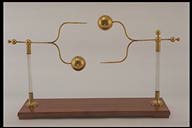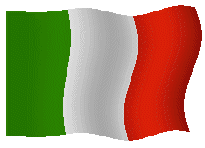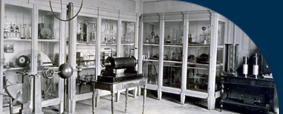
 |
Double forked electrostatic discharger [1] |
 |
Scaricatore elettrico a doppia forcella [1] |
| Subjects: electrostatics/theory of electrical dispersion in air |
Settore: elettrostatica/teoria della dispersione dell'elettricità nell'aria |
| Inventory Number: 256 |
Numero di inventario: 256 |
| Engraved on the mahogany base: "Secretan à Paris" |
Sulla base di mogano: "Secretan a Paris" [inciso] |
| 1865 [document] |
Periodo di costruzione: 1865 [documento] |
| £ 36 [document] |
Prezzo d'acquisto: £ 36 [documento] |
| Mahogany, brass, glass |
Materiali utilizzati: Mogano, ottone, vetro |
| 645 X 190 X 430 [mm] |
Dimensioni: 645 X 190 X 430 [mm] |
| |
|
A surviving document reveals that the instrument was purchased from the French mechanician Secretan for the price of £ 36. It is referred to as "Faraday's device for the electrical discharge from a ball to a point." This instrument was invented in the wake of an intense debate, which since the mid 1830s had developed mainly in England, France and Italy, concerning the different capacity of dissipation between negative and positive electricity in the air. In particular, the studies of the physicists Faraday, Peltier and Bellli contributed to highlighting of the main features of an electric discharge produced through pointed and spherical conductors. In Italy the physicist Giuseppe Belli (1791-1860), in order to prove that negative electricity, in similar conditions, dissipates in the air more easily than positive electricity, created this simple device the explanation of which dates back to 1837. One of his original models is still maintained in the Physics Museum of the University of Pavia. At the same time that Belli was carrying out his studies, the English physicist Faraday was also dealing with the problem of the dissipation in the air of the two kinds of electricity, which he extended -as Belli had done- to other gases as well, by carrying out experiments that were very similar to those conducted by the physicist who was working in Pavia and by using an identical double forked discharger. This device allowed for the comparison and studyof the discharge between the point and a brass sphere opposite it, with an equal distance between the two points and charged with different potentials. |
Da un documento risulta acquistato dal meccanico francese Secretan al prezzo di £ 36. Esso è indicato come «Apparecchio di Faraday per la scarica elettrica da una palla ad una punta». Questo apparecchio fu progettato sulla scia di un intenso dibattito sulla diversa capacità di dispersione dell'elettricità negativa e positiva nell'aria che, a partire dalla metà degli anni trenta dell'ottocento, si sviluppò soprattutto in Inghilterra, Francia ed Italia. In particolare i fisici Faraday, Peltier e Belli contribuirono con i loro studi ad evidenziare le principali caratteristiche della scarica elettrica prodotta attraverso conduttori appuntiti e sferici. In Italia il fisico Giuseppe Belli (1791-1860) nell'intento di mostrare che l'elettricità negativa, a parità di condizioni, si disperde nell'aria più facilmente di quella positiva, progettò questo semplice dispositivo (la memoria esplicativa è del 1837); un suo esemplare originale è tuttora conservato presso il Museo di Fisica dell'Università di Pavia. Contemporaneamente agli studi del Belli, anche il fisico inglese Faraday affronta il problema della dispersione delle due elettricità nell'aria (che estende, come aveva fatto del resto anche il Belli, anche ad altri gas) sviluppando esperimenti molto simili a quelli del fisico pavese ed utilizzando un identico scaricatore a doppia forcella. Questo permetteva di comparare e studiare, a parità di distanza esplosiva, la scarica tra la punta ed una sfera d'ottone ad essa affacciata, caricate a differenti potenziali. |
| |
|
Description: Two glass columns on a rectangular mahogany base support a brass spark gap whose arms, which slide horizontally along screw grooves, end with a pair of forks that are opposite each other, each having both a point and a sphere. By appropriately rotating the forks, it is possible to achieve the configurations sphere-point, point-point, and sphere-sphere. |
Descrizione: su una base rettangolare in mogano due colonne di vetro sostengono uno spinterometro completamente d'ottone i cui bracci, scorrevoli orizzontalmente su scanalature a vite, terminano con una coppia di forcelle affacciate l'una di fronte all'altra, portanti ciascuna una punta e una sfera. Ruotando opportunamente le forcelle, è possibile ottenere le configurazioni sfera-punta, punta-punta e sfera-sfera. |
| |
|
Function: The study of the discharge between a point and a sphere was carried out by charging a fork with a Leyden jar, whereas the other fork was placed on the ground: if the sphere and the point of a tine were positively charged, the point and the sphere that were opposite them were negatively charged by induction, thereby determining the discharge only in the sphere (+)-point (-) system; and vice versa, by negatively charging the tine, the spark was produced only in the point (-)-sphere (+) system. This indicated that negative electricity dissipates more easily from a point than does positive electricity. Furthermore, Belli thought that the instrument could even be used to explore the sign of atmospheric electricity during thunderstorms: for that purpose it was sufficient to connect a fork of the device with a Franklin bar or with a metal wire of a kite, and to place the other fork on the ground. |
Funzionamento: lo studio della scarica tra punta e sfera ad essa affacciata avveniva caricando una forcella con una bottiglia di Leida mentre l'altra veniva posta a terra: se la sfera e la punta di un rebbio erano caricate positivamente, la punta e la sfera ad esse affacciate si caricavano per induzione negativamente determinando la scarica nel solo sistema sfera (+) -punta (-); viceversa, caricando negativamente il rebbio si evidenziava lo scoccare della scintilla nel solo sistema punta (-)-sfera(+). Ciò mostrava che da una punta l'elettricità negativa si disperde nell'aria più facilmente rispetto a quella positiva. Inoltre, secondo il Belli, lo strumento poteva anche essere utilizzato efficacemente per esplorare il segno dell'elettricità atmosferica durante i temporali: bastava a tal proposito collegare una forcella dell'apparecchio con una spranga frankliniana o con un filo metallico di un cervo volante e porre l'altra forcella a terra. |
| |
|
Bibliography: Faraday's Diary [february, 1836] vol, 2, pp. 443-453; Belli [1837], vol. 86, pp. 283-284, table 2, fig. 4; Faraday [1838], pp. 495; 497-499; plate 11, fig. 3 and 4; Bellodi, Brenni [1994], p. 92. |
Bibliografia: Faraday's Diary [february, 1836], Vol. II, pp. 443-453; Belli [1837], Tomo LXXXVI, pp. 283-284, Tav. II, fig. 4; Faraday [1838], pp. 495; 497-499. |
| |
|
[1] From a request for funding by Serpieri, datated March 29, 1865, in order to pay for instruments coming from Paris: "Faraday's Device for electrical discharge from a sphere to a point £ 36". |
[1] Da una richiesta di fondi del Serpieri, datata 29 marzo 1865, per pagare gli apparecchi venuti da Parigi: "Apparecchio di Faraday per la scarica elettrica da una palla ad una punta £ 36". |
|
|
|

